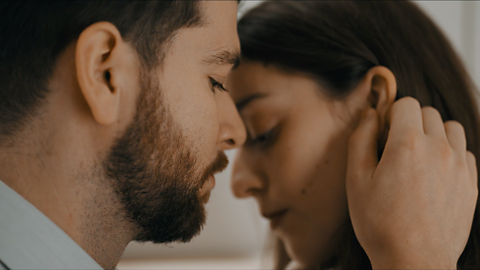
PLEASE NOTE: These films are intended for use with students over 15. The films contain content which some people may find upsetting; students may also have had direct or indirect experience of a controlling relationship. You should view each part and read the accompanying guidance (at the bottom of this page) on creating a safe teaching and learning environment before using with students, considering its suitability for your cohort with care.
Coercive control is a pattern of behaviour by an abuser to harm, punish or frighten their victim. ItÔÇÖs been illegal since 2015, but would we be able to spot it if we saw it happening?
To find out, 91╚╚▒Č Three and journalist Ellie Flynn brought together 20 people aged 18-25 from across the UK to explore whether they know what coercive control actually is. Over two days, the group watch a specially-written drama telling the story of the relationship between Rachel and Alex. As the drama progresses, it becomes clear that the young people have different perceptions of the events in the story. Some think that what they are being shown amounts to normal behaviour in a relationship, while others believe that a line has been crossed.
At the end, the group hear from barrister Clare Ciborowska, who analyses the events in Rachel and AlexÔÇÖs story. She explains the law and reveals the answer to the key question posed by the programme ÔÇô is this coercive control?
Below you will find a special edited version of the drama for classroom use, in five parts.
Each part is accompanied by discussion notes. These discussion notes are for guidance only. You may wish to use different questions or statements to stimulate discussion, depending on your cohort.
During discussion it is important to revisit and emphasise any previous teaching about what to do if a relationship feels unhealthy or unsafe, including speaking to someone about it and retaining any evidence such as photos, text messages or voicemails, writing these down if necessary. It is also important to signpost students to sources of help should they or anyone they know need it, including named members of staff in school. Students should be reassured throughout that if they, or someone they know, find themselves in a controlling relationship, then if they report it they will be believed and helped.
Students should also be made aware that although the films show a relationship between a man and a woman, coercive control can happen in a relationship regardless of gender, age, race, socio-economic status, sexual orientation, disability or background.
Click or tap here for information and support from the 91╚╚▒Č Action Line website.

Part 1
Rachel and Alex have celebrated three months together and heÔÇÖs met her work mates. When Rachel loses her job, Alex asks her to move in with him.
Notes for discussion
Does the relationship seem healthy (you could ask students for their opinions and to identify clues)?
Are there any warning signs about either characterÔÇÖs behaviour?
Identify any clues as to the charactersÔÇÖ feelings about one another.
Collate any thoughts, opinions or questions at the end of this part.
Part 2
Rachel and Alex are living together in AlexÔÇÖs flat while Rachel tries to find a new job.
Notes for discussion
How does the relationship seem now?
Are there any warning signs about either characterÔÇÖs behaviour?
Identify any clues as to the charactersÔÇÖ feelings about the relationship or one another.
Do either of the characters seem different, or to be changing their behaviour as a result of things the other has said or done?
How might AlexÔÇÖs behaviour be affecting Rachel?
Is there anything else that raises questions or concerns?
Collate any thoughts, opinions or questions at the end of this part.
Part 3 - Rachel's Evidence
With the help of her friend, Rachel brings a case of coercive control against Alex, and gives her evidence in court. Before viewing this part it may help to define coercive control for your students and explain that Rachel has brought a case against Alex. Ask them to identify reasons why she might have accused him of coercive control, and compile a ÔÇśforÔÇÖ and ÔÇśagainstÔÇÖ list of evidence.
Notes for discussion
How does Rachel seem at the beginning of this film? Identify any clues that the relationship affecting her feelings or behaviour.
Why is RachelÔÇÖs friend important? (Reinforce messages around the importance of speaking to a friend/family member, or a trusted source such as a helpline if someone feels afraid or unsafe).
Discuss RachelÔÇÖs evidence and how it compares to the ÔÇśforÔÇÖ and ÔÇśagainstÔÇÖ evidence that the class drew up.
Are there any other clues as to RachelÔÇÖs feelings?
What does the class think the verdict should be having heard RachelÔÇÖs evidence?
Is there anything that raises questions or concerns?
Share any thoughts, opinions or questions at the end of this part.
Part 4 - Alex's Evidence
Alex is cross-examined in court.
Notes for discussion
Discuss AlexÔÇÖs evidence and how it compares to the ÔÇśforÔÇÖ and ÔÇśagainstÔÇÖ evidence that the class drew up.
What does the class think the verdict should be having heard AlexÔÇÖs evidence?
Is there anything that raises questions or concerns?
Share any thoughts, opinions or questions at the end of this part.
Part 5 - What is coercive control?
Barrister Clare Ciborowska explains the law and answers the question posed by the drama: Is this coercive control?
Notes for discussion
Discuss the lawyerÔÇÖs explanation of coercive control.
Does the class think Alex will be convicted? Why/why not?
Share any thoughts, opinions or questions at the end of this part.
You may want to explore the Serious Crime Act and other forms of relationships-based behaviour which are defined in law as part of further citizenship or relationships education learning.
Safe teaching and learning
Ensure a safe environment for use by doing the following for each lesson in which the videos are used:
Create or revisit ground rules
Remind pupils of any existing ground rules you might already use, or agree ground rules with them before the lesson. Examples could include:
- Judge and comment on what other students say, not on who they are
- Discuss the situations of the characters in the videos, not othersÔÇÖ personal experiences
- Everyone has the right to pass
Encourage and respond to questions safely
Use techniques such as an anonymous question box or post-its to enable students to ask questions privately and anonymously if they wish to. This can also help you prepare responses to challenging questions, or identify any potential safeguarding issues or disclosures.
Be sensitive to individual students who may be living with or have experience of controlling relationships, either directly or indirectly. Sensitivity is important even if you are not aware of any personal experiences in the class ÔÇô working on the basis that there is at least one person who may be vulnerable ensures safe delivery for all. No-one should feel under any pressure to discuss their own circumstances or experiences.
Always work within your schoolÔÇÖs safeguarding and confidentiality policies and procedures
This is especially important if a student makes a disclosure. If you are unsure of the procedures, seek advice from your Designated Safeguarding Lead, or contact the NSPCC on 0808 800 5000.
Signpost students to sources of additional information or support if they need it, including named adults within school. Click or tap here for information and support from the 91╚╚▒Č Action Line website. Definitions and explanations of coercive control with links to relevant documentation are below.
Using the videos for discussion and further activities
The drama is divided into five parts which can be used flexibly to suit your teaching needs, depending on your cohort, scheme of work, subject/topic area, learning objectives, etc. You can choose how to view each part with your students ÔÇô however, it is advised that you allow time during or between each part for questioning and discussion, and to allow students time to follow the story as it develops. It is also advisable to allow some quiet reflection time at the end of the lesson before students leave the classroom.
The following notes are general suggestions for ways to structure discussion or develop further opportunities for understanding. You may choose not to tell students that this is a story about coercive control until the final parts ÔÇô in this way they can explore indicators and impacts of healthy versus unhealthy relationships, before being introduced to what is recognised in law.
During discussion it is important to revisit and emphasise any previous teaching about what to do if a relationship feels unhealthy or unsafe, including speaking to someone about it and retaining any evidence such as photos, text messages or voicemails, writing these down if necessary. Students should be reassured throughout that if they, or someone they know, find themselves in a controlling relationship, then if they report it they will be believed and helped. Students should also be told that although this resource focuses on relationship between a man and a woman, coercive control can happen regardless of gender, age, race, socio-economic status, sexual orientation, disability or background.
Before showing the first video, ask students to consider and discuss any features of a healthy relationship, and collate these on a graffiti wall, or as a mind map or class list. Then ask them for any signs of an unhealthy relationship and record these in the same way. Keep these to refer to as reminders or for consideration during future discussion.
After watching each film, allow plenty of time for discussion and sharing of perceptions and opinions. Group students in a way that suits your needs, but always ensure sharing of responses so that everyone in the class hears from one another.
Try to lead the discussion with impartial and non-judgemental questioning that encourages students to form their own opinions e.g. ÔÇśWhat might Rachel be feeling? What are the clues?ÔÇÖ rather than ÔÇśWhy is Rachel scared?ÔÇÖ Encourage students to both support and challenge one another.
Ask students about evidence for their responses e.g. if they think something isnÔÇÖt right, what are the clues? Encourage them to look at body language and expressions as well as what the characters say, including clues as to what may have happened off-camera.
Finish sessions by summing up the story so far, and writing down any notes or unanswered questions. Encourage students to suggest what they think might happen next, or how they think the story will conclude.
Before watching each new part, recap on the story so far and look at the notes from the previous part. Have questions been answered? Were any predictions correct? Have anyoneÔÇÖs perceptions changed?
Techniques such as those outlined below can be useful ways of exploring studentsÔÇÖ responses and reasons for them. These can be used at the beginning and end of a lesson, or returned, to gauge how opinions can change as more of the story is revealed.
- Continuum line: label extremes at either end of an imaginary line across the classroom e.g. Strongly agree; Strongly disagree. Ask students to stand on the line depending on the strength of their feeling about different statements, and ask them to explain reasons for their positioning. After hearing different responses, give students the opportunity to change places on the line.
- Conscience alley: students form two lines facing one another, creating an ÔÇśalleyÔÇÖ which others walk down. Ask a question e.g. Is Alex being loving or controlling? then ask those forming the alley to give opposing opinions as another student walks down it. At the end of the alley, the walker needs to consider all they have heard and decide on their own verdict.
- Corners: place a different statement in each corner of the room (or adapt for use e.g. statements on walls or tables). Students move to the statement with which they most agree, or remain in the middle of the room if they are undecided. Ask students in different corners to share their reasoning, then give students the opportunity to change positions.
Coercive control and the law
Under the Serious Crime Act, coercive control became illegal in England and Wales in December 2015. Controlling or coercive behaviour in intimate or family relationships is an offence carrying a maximum sentence of five years imprisonment, and/or a fine. Two top-level definitions are below with key words that might aid discussion highlighted ÔÇô please see the sources for further information and detail.
- Coercive behaviour is an act or a pattern of acts of assault, threats, humiliation and intimidation or other abuse that is used to harm, punish, or frighten their victim
- Controlling behaviour is a range of acts designed to make a person subordinate and/or dependent by isolating them from sources of support, exploiting their resources and capacities for personal gain, depriving them of the means needed for independence, resistance and escape and regulating their everyday behaviour
These short films might be useful for teaching relationships, sex and health education, citizenship, or PSHE in England. They might be useful for teaching health and wellbeing education in Scotland, learning for life and work in Northern Ireland, and PSE in Wales.
If your students need support
You should always tell someone about the things youÔÇÖre worried about. You can tell a friend, parent, guardian, teacher, or another trusted adult. If you're struggling with your mental health, going to your GP can be a good place to start to find help. Your GP can let you know what support is available to you, suggest different types of treatment and offer regular check-ups to see how youÔÇÖre doing.
If youÔÇÖre in need of in-the-moment support you can contact , where you can speak to a counsellor. Their lines are open 24 hours a day, 7 days a week.
There are more links to helpful organisations on 91╚╚▒Č Action Line.
Where next?
Football, Prince William and our mental health. collection
A series of short films based on HRH The Duke of Cambridge's mental health campaign, with focus on men's mental health.

Digital Literacy. collection
A series of short films for secondary schools, which provide students with a toolkit for navigating the online world.

Mimi on a Mission: Sex Ed. collection
Documentary series following YouTuber Mimi Missfit as she takes seven teenagers to Holland to find out how they teach relationships and sex education.
